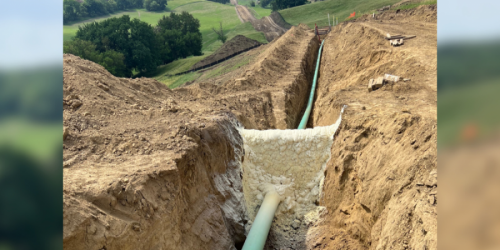Q&A Forums
Mold and Icynene Post New Topic | Post Reply
| Author | Comments |
|---|---|
|
Brian Bothun
Posted: Apr 01, 2010 06:54 PM
|
Mold and Icynene
I started my house 2 falls ago, capped the basement and had the ceiling sprayed with Icynene for a immediate insulation and sound barrier as the rest of the house was finished. Now that they have ran all the ductwork and had to rip some of the foam out, they noticed that where the foam meets the flooring it is wet and is full of black mold. I've checked 5-6 different places and they are all the same, wet and moldy. Why is the moisture not draining and what should be my first steps to fixing this other then to rip it all out and bleach.
|
|
mason
Posted: Apr 02, 2010 09:18 AM
|
When installed next to studs and sheathing, water can be absorbed into the open cell foam. While gravity would allow some of this water to drip out, some of it will stay in the foam. As much as I regret saying it, you need to remove the wet foam, treat the wood and respray. But, find the source of the water leaking into the foam and fix it first. You haven't mentioned where the house is located, so I don't know if this the wet foam is caused by a water leak or condensation against the sheathing. If you are in a cold environment, open cell foam requires a vapor retarder on the warm side of the insulation to minimize the potential for condensation. |
|
jimcoler
I have over 10 years of experience specifying and installing open and closed cell spray foam. I've sold my business but I'm still selling for the new owners and consulting on large and custom specific jobs. I've expanded my knowledge into t Posted: Apr 03, 2010 09:18 AM
|
So, I agree with Mason to some extent. The first step is to identify the source of the moisture and stop it. In many cases this can be coming from the basement walls or the basement floor or both! Do you have a GOOD vapor retarder on the walls and floor? If not, I would take care of that first. Then it should dry out. Without addressing the root cause of the problem, you just chase the issue to another area which becomes a problem. I wouldn't believe all that's been said about mold and it's dangers because most of these are just sales tactics and lame ones at that. |
|
Posted: Apr 03, 2010 10:58 AM
|
worth a try,,, pull out the bottom inch or so,,, create a drainage plane,,,let it drip its way dry,,(the skin of open cell foam will hold moisture in,,particularly in horizontal apps) mechanical dehumidification will help as well... the beauty of spray foam,,,if a drainage plane is present the material will return to its original state,,not loosing its physical properties or insulative value,,much like the traditional products do... and if you tear it all out,,put down a couple of inches of CC foam and consider it a lesson learned.. i prefer cc on foundations...vapor retarding membrane out beyond 1.5"-2" or so.... jim,,mold is real,,it can cause funky schtuff to the right folks,,with the right mold,,and the right conditions... that being said,,i like you dont "sell" to the mold game,,,if asked i describe the conditions needed for mold growth,,and then describe how a properly installed spf system should reduce the chance for those conditions to occur,, peace ps: fax headed your way,,quentins to..heads up mason,,workin on original for best photos and will forward when scanned... |
|
Posted: Apr 05, 2010 11:29 PM
|
While we are on the subject, what do you guys consider to be a vapor retarder? |
|
mason
Posted: Apr 06, 2010 09:05 AM
|
The term "vapor retarder" is relative to the climate zone, type of construction, design, building materials, building use, etc. In the 2009 IBC and IRC building codes, 3 types of vapor retarders are listed. Types of Vapor Retarders: (As defined by desiccant method procedure A of ASTM E 96 procedure) • Class I vapor retarder: > 0.1 perms • Class II vapor retarder 0.1 - 1.0 perms • Class III vapor retarder < 1.0 - > 10.0 perms Many materials can be considered relative vapor retarders depending on the climate, building design and other building materials used in the construction. Other materials are always considered vapor retarders or vapor barriers. A Class I vapor retarder would be most beneficial in more extreme designs and climates where the moisture vapor drive is consistently in one direction. Examples would include: • Cold Storage facilities, coolers, freezers, etc • Swimming pools, saunas, aquariums, etc. • Agricultural buildings such as potato & poultry shed alligator farms, etc. • High occupancy buildings such as indoor athletic stadiums • Extreme northern or consistently cold climates In these situations a moisture vapor drive is always going in one direction. A Class I vapor retarder is placed on the warm side of the insulation, effectively stopping water vapor diffusion before it can get into the insulation and other building components causing condensation. Types of Class I vapor retarders include: • Metal sheets or skins • Polyethylene film plastic • Rubber membranes such as Neoprene (add trademark symbol) • Asphaltic membranes • Very low perm rated coatings such as Hypalon, (add trademark symbol), butyl rubber, asphaltic coatings Class II Vapor Retarders: Class II vapor retarders can be used in typical residential and commercial construction in all climate zones of the US. A Class II vapor retarder effectively slows moisture vapor diffusion to the extent that condensation does not occur under normal circumstances that one would expect in typical construction. Types of Class II vapor retarders would include: • Closed cell spray polyurethane foam (SPF) in sufficient thickness (including medium and high density) • Kraft faced fiberglass batt insulation • Foil faced polyiso sheathing • Low perm rated paints or coatings such as epoxy, polyurea and some polyurethane coatings Class III Vapor Retarders: Class III vapor retarders have higher perm ratings and should be used in situations where a flow-through moisture vapor design is desired or where potential condensation issues related to higher perm rated products have been addressed (such as venting attic spaces) Types of Class III Vapor Retarders would include many common building materials such as: • Latex or enamel paint • Low density SPF (in sufficient thickness) • Plywood or OSB • Gypsum wallboard Types 1 & 2 are acceptable in all climate zones of the US for typical residential or commercial construction. Type 3 is acceptable in climate zones 1-4 without an additional vapor retarder element and acceptable in climate zones marine 4 and 5-8 with a class 1 or II vapor retarder. |
|
Posted: Apr 06, 2010 05:16 PM
|
Thanks for the quick lesson on Vapor Retarders Mason. I found it very useful! Steve |





























